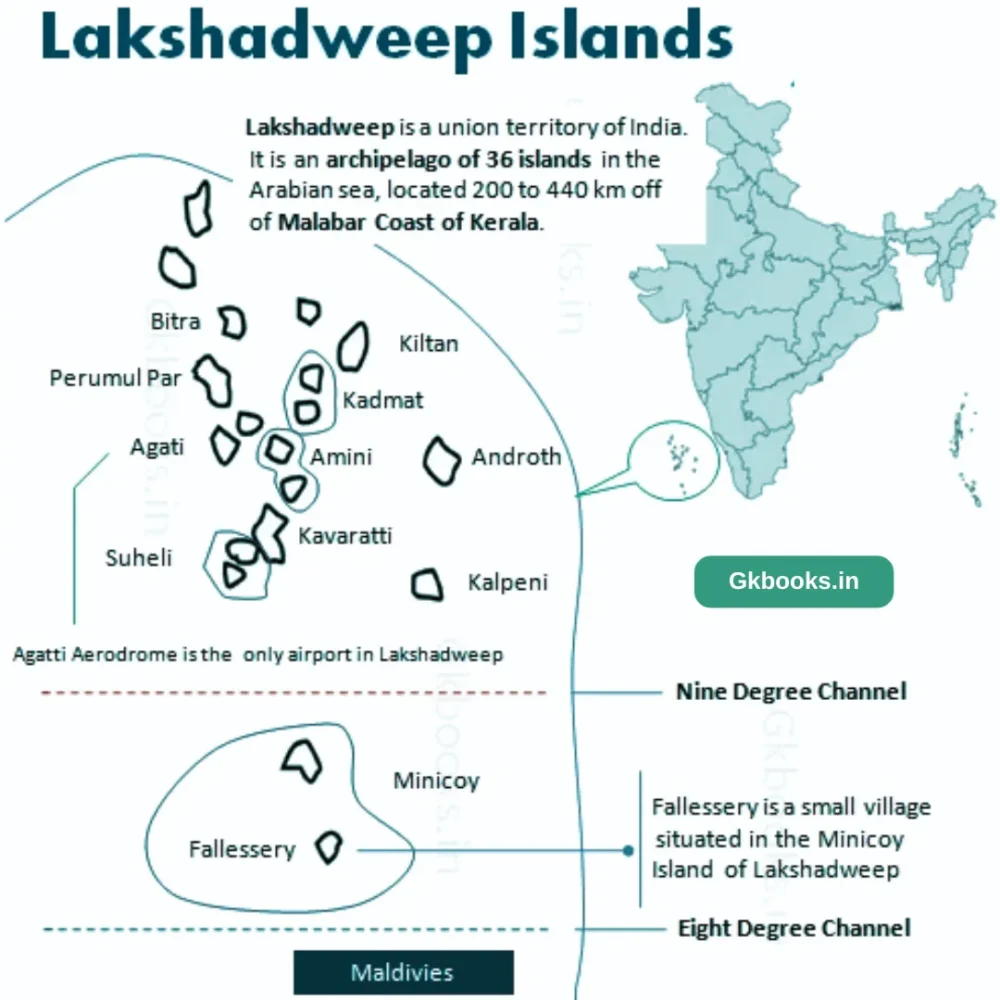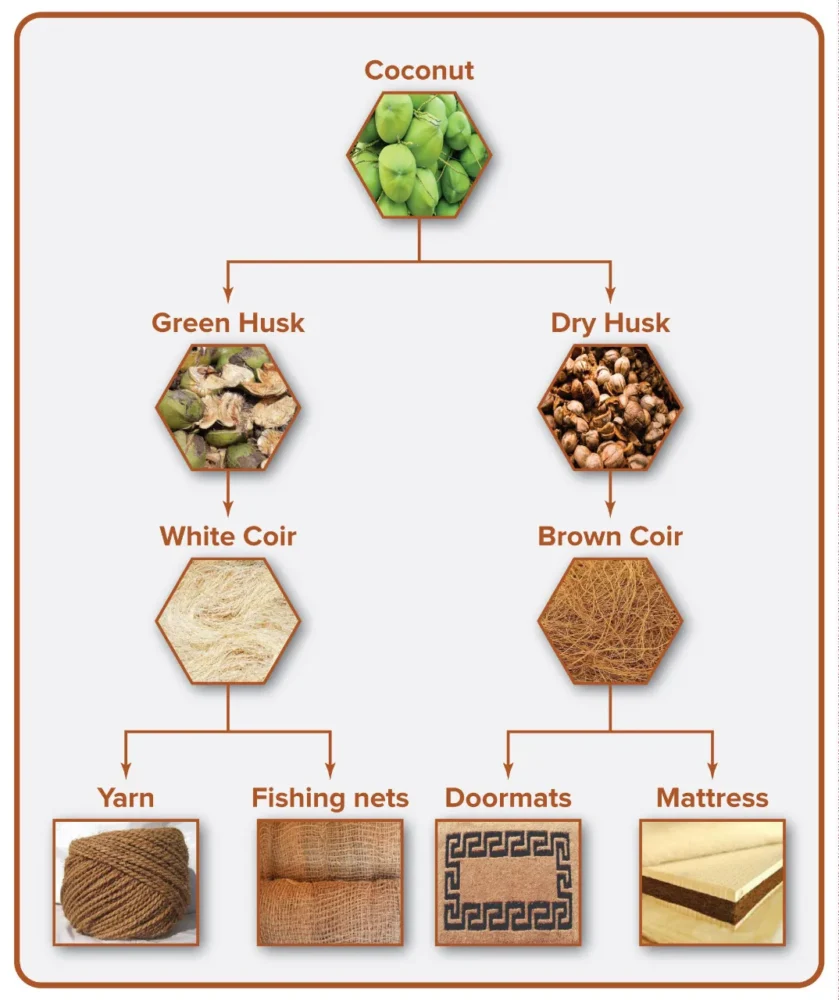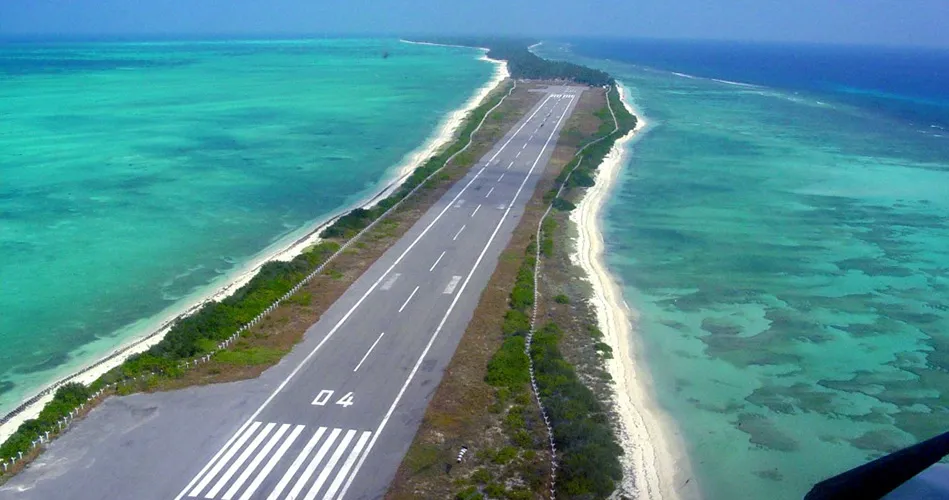Lakshadweep, often called India’s own Maldives, is a group of stunning tropical islands in the Arabian Sea. This Union Territory of India is known for its captivating beauty, rich cultural heritage, and unique geography. Let’s delve into various aspects of Lakshadweep, including its culture, geography, languages, economy, and more.
Also See: List of 8 UT's of India with Capital
Lakshadweep Overview
| Lakshadweep in a Nutshell | |
|---|---|
| Coordinates | 10.57°N 72.64°E |
| Country | India |
| Region | South India |
| Formation | 1 November 1956 |
| Capital | Kavaratti |
| Largest City | Andrott |
| Lok Sabha Member | Mohammed Faizal Padippura |
| High Court | Kerala High Court |
| Area (Total) | 32.62 km2 (12.59 sq mi) |
| Area Rank | 36th |
| Population (2011) | 64,473 |
| Population Density (2011) | 2,000/km2 (5,000/sq mi) |
| Official Languages | Malayalam, English |
| Time Zone | UTC+05:30 (IST) |
| Vehicle Registration | LD |
| HDI (2019) | 0.751 (4th) |
| Literacy (2011) | 91.85% |
| Sex Ratio (2011) | 947♀/1000 ♂ (1st) |
| Website | lakshadweep.gov.in |
| Emblem |  |
| Bird | Brown Noddy |
| Fish | Butterfly Fish |
| Tree | Bread Fruit |
Read More: Check out the Top 100 MCQs on Lakshadweep including Current Affairs
A Brief Overview of Lakshadweep
Location
- Lakshadweep, a union territory of India, comprises 36 islands forming a maritime boundary between the Arabian and Laccadive Sea.

Meaning of Lakshadweep
- The name “Lakshadweep” translates to “one lakh islands” in Malayalam and Sanskrit, despite having fewer than a hundred islands.
Demographics and Language
- Jeseri is the primary language spoken in the territory.
- Jeseri is spoken in most inhabited islands, except in Minicoy, where Dhivehi is the primary language.
- The Ponnani script of Malayalam was historically used to write Jeseri.
- The islands have a total surface area of approximately 32 km², with a lagoon covering about 4,200 km².
What is Lagoon? and How it formed? : To know this read the eartheclipse article on Lagoon
Administrative Setup
- Kavaratti serves as the capital, forming a single Indian district with 10 subdivisions under the jurisdiction of the Kerala High Court.
Historical Significance
- Lakshadweep has historical references in Buddhist Jataka stories dating back to the sixth century BCE.
Dynasties and Colonial Period
- Islam was established in the region around the seventh century.
- It was ruled by Chera, Chola, and the Kingdom of Kannur during the medieval period.
- The Portuguese arrived in 1498, later expelled, and the region was under Tipu Sultan’s rule until 1799.
Formation of Union Territory
- After Tipu Sultan, most of the region passed to the British, and the Union Territory was formed in 1956.
Island Dynamics
- Originally consisting of 36 islands, one island submerged due to sea erosion, leaving 35 islands.
Population and Religion
- 10 of the 36 islands are inhabited, with a population of 64,473 per the 2011 census.
- Most of the population is Muslim, following the Shafi school of the Sunni sect.
Cultural Similarities
- The culture of Lakshadweep is akin to that of Mappilas in the nearby mainland state of Kerala.
Economic Activities
- An airport primarily serves the islands on Agatti Island.
- The main occupations include fishing and coconut cultivation, with tuna being a major export item.

Formation History of Lakshadweep
Ancient Settlements
- The islands, lacking aboriginal inhabitants, have different suggested histories for their settlement.
- Archaeological evidence indicates human settlement around 1500 BCE, with Jataka stories of Buddhism mentioning the islands’ connection to the spread of Buddhism during the 6th century BC.
- The oldest inhabited islands include Amini, Kalpeni, Andrott, Kavaratti, and Agatti.
Islamic Influences
- Islam is believed to have been brought to Lakshadweep by Ubaidullah in 661 CE, with his grave on Andrott Island.
- The history of Islam in Lakshadweep is documented in the Arabic book ‘Futhuhathul Jaza’ir,’ authored by Abubakar ibn Ubaidulla.
Medieval Period
- In the 11th century, the islands came under the rule of the Late Cholas and later the Kingdom of Kannur.
- The islands played a vital role in the Indian Ocean trade during the medieval period, positioned in the principal trade route connecting the Middle East with the Malabar Coast, Ceylon, and Southeast Asia.
Portuguese Rule and Expulsion
- In the 16th century, the Portuguese took control of the archipelago for coir production.
- Expelled by islanders in 1545, the inhabited islands were conferred as jagir to the ruling family of the Cannanore Kingdom for protection against the Portuguese.
Tipu Sultan and British Control
- The Aminidivi group of islands came under Tipu Sultan’s rule in 1787 and later passed to British control after the Third Anglo-Mysore War.
- The rest of the islands remained under the suzerainty of the Arakkal family until the British Raj.
Formation of Union Territory
- On November 1, 1956, during the reorganization of Indian states, Lakshadweep became a separate union territory, initially named Laccadive, Minicoy, and Amindivi Islands.
- Renamed Lakshadweep on November 1, 1973, the territory’s headquarters shifted to Kavaratti in 1964.
Strategic Importance and Indian Navy Base
- In response to the islands’ growing security significance and to safeguard shipping lanes to the Middle East, INS Dweeprakshak, an Indian Navy base, was commissioned on Kavaratti Island.
Geography of Lakshadweep
Geographical Composition
- Lakshadweep is an archipelago consisting of twelve atolls, three reefs, and five submerged banks, totaling around thirty-six islands and islets.
- Atolls, reefs, and submerged banks contribute to the unique geography, mostly northeast–southwest orientation and enclosed lagoons.
Island Distribution
- The archipelago comprises ten inhabited islands, 17 uninhabited islands, attached islets, four newly formed islets, and five submerged reefs.
- Key islands include Kavaratti, Agatti, Minicoy, and Amini.
Population and Connectivity
- The total population of Lakshadweep is 64,473 according to the 2011 census.
- Agatti has an airport with direct flights from Kochi, facilitating accessibility.
Ecological Significance
- The Aminidivi and Laccadive subgroups of islands, along with Minicoy Island, collectively form the Coral Islands of India in the Arabian Sea.
- Rich biodiversity includes over 600 species of marine fish, 78 species of corals, 82 species of seaweed, and diverse bird species.
Coral Reef Region
- Lakshadweep Archipelago, the Maldives, and the Chagos form the Maldives-Lakshadweep-Chagos Archipelago tropical moist forests ecoregion.
- The region is one of India’s four coral reef regions, attracting tourists with its vibrant corals.
Wildlife and Conservation
- Pitti Island is a significant breeding place for sea turtles and various pelagic birds, declared a bird sanctuary.
- Cetacean diversity is notable, including various whales, smaller cetaceans, and dolphins.
Local Symbols
- Animal: Butterflyfish
- Bird: Noddy tern
- Tree: Breadfruit
- Flower: Not designated
Flora and Fauna
- Lakshadweep exhibits a limited flora, with plants found on the mainland of India.
- Approximately 400 species of flowering plants have been documented, including seagrasses, angiosperms, fungi, algae, and lichens.
- Common flora on coral sands include coconut groves, coastal shrubs, and various seaweeds.
Environmental Conservation
- The region faces a lack of scientific study, hindering understanding and conservation efforts.
- The island has been declared a bird sanctuary, emphasizing the importance of preserving its unique ecology.
Government and administration
Administrative Governance
- Lakshadweep is one of India’s eight union territories, constituting a single Indian district with ten sub-divisions.
Administrative Leadership
- Governed by an administrator appointed by the President of India under Article 239 of the Constitution.
- The current administrator is Praful Khoda Patel.
Sub-Divisions and Development Coordination
- Ten sub-divisions exist; Minicoy and Agatti have Deputy Collectors overseeing them.
- Sub-divisional officers coordinate developmental activities on the remaining eight islands.
District Administration
- The Collector cum Development Commissioner, also the District Magistrate, oversees matters like revenue, land settlement, law, and order.
- Assisted by an Additional District Magistrate and ten Executive Magistrates for law and order enforcement.
Law Enforcement
- The Administrator, as the Inspector General of Lakshadweep Police, holds command and control over the Lakshadweep Police.
- The Administration Secretariat is based in Kavaratti.
Judiciary System
- Falls under the jurisdiction of the Kerala High Court at Kochi, sharing a system of lower courts.
- Since 1997, the District and Sessions Court in Kavaratti has been the court of first instance for Lakshadweep.
- Two Munsiff Courts in Andrott and Amini serve the union territory.
- Judges and judicial magistrates may include officers from mainland Kerala, serving on a rotational basis since 1969.
Recent Judicial Developments
- In December 2022, a significant milestone was achieved with the appointment of a female judicial officer to the island, marking a notable first.
Political Representation
- The territory elects one member to the Lok Sabha, the lower house of the Indian Parliament.
- The Lakshadweep Lok Sabha Constituency is reserved for Scheduled Tribes, ensuring representation for marginalized communities.
Demographics
Population Overview
- As per the 2011 census, Lakshadweep’s population stands at 64,473, ranking 627th among the 640 districts in India.
Urban and Rural Distribution
- Lakshadweep has an urban population of 50,332 (78%) and a rural population 14,141 (22%).
- The district boasts a high population density of 2,013 inhabitants per square kilometre.
Population Growth and Sex Ratio
- The population growth rate from 2001-2011 was 6.23%.
- Lakshadweep maintains a sex ratio of 946 females for every 1000 males.
Literacy and Fertility Rates
- The literacy rate in Lakshadweep is 92.28%, reflecting a well-educated populace.
- The fertility rate in Lakshadweep is notably low at 1.4, well below the national average.
Ethnic Composition
- Most of Lakshadweep’s residents are descendants of migrants from the Malabar Coast of southwest India.
- Ethnically similar to coastal Kerala’s Malayali people, forming a cultural connection with the mainland.
Religious Demographics
- More than 93% of the resident population in Lakshadweep follows Islam.
- The majority adheres to the Shafi School of the Sunni Sect.
Special Population
- The southernmost and second-largest island, Minicoy, hosts an ethnically Mahls population native to the Maldives.
Religion
Dominant Religion
- Islam is the primary religion practised in Lakshadweep, significantly influencing the culture and way of life.
Religious Founder
- Sheikh Ubaidullah is credited with propounding Islam in Lakshadweep.
Religious Practices and Festivals
- Muslims constitute most of the population in Lakshadweep, and key Islamic festivals are widely observed.
- Prominent occasions include Eid-ul-Fitr, Muharram, Eid-ul-Adha, and Milad-un-Nabi, bringing the islanders together in various mosques for communal prayers.
Cultural Similarities
- The cultural practices in Lakshadweep bear a strong resemblance to that of Mappilas, the Muslim community in the nearest mainland state of Kerala.
Religious Observance
- Moulood is a significant religious event in Lakshadweep, marked by prayers for divine power and communal meals, fostering a sense of community.
- The festival of Ratheeb, originating in the Kavaratti region, holds a unique place. During Ratheeb, the islanders honour the grave of Sheikh Kasim, a revered saint, seeking his holy blessings.
Cultural Significance
- Religious observance in Lakshadweep is deeply ingrained in the core ethnic groups, contributing to the rich cultural tapestry of the islands.
Languages
Principal Languages
- Malayalam and Dhivehi are the principal languages spoken in Lakshadweep.
Jeseri Dialect
- The people of the northern islands, including Chetlat, Bitra, Kiltan, Kadmat, Amini, Kavaratti, Androth, Agatti, and Kalpeni, speak Jeseri.
- Jeseri is a dialect of Malayalam with influences from Arabic, resembling Arabi Malayalam.
Mahl Language
- Minicoy, the southernmost atoll, has its own distinct language called Mahl, which is a variant of the Divehi language spoken in the Maldives.
Historical Language Shift
- During the British Raj, Malayalam with Malayalam script replaced a type of Arabic script (Ponnani script or Arabi Malayalam script) as the primary language in Lakshadweep.
- The Indian government continued this language policy.
Role of Malayalam
- Malayalam serves as a link language across the islands, even in Mahl-dominated Minicoy Island.
Diverse Dialects
- Each island in the archipelago has its own dialect, contributing to linguistic diversity in Lakshadweep.
Cultural Expressions
- The diverse linguistic landscape is reflected in cultural expressions, including traditional dances such as Lava Dance, Kolkali Dance, and Parichakli Dance.
Economy of Lakshadweep
Economic Overview
- Lakshadweep’s gross territorial domestic product in 2004 was estimated at ₹3.24 billion, equivalent to ₹11 billion or US$140 million in 2023.
Coconut Fiber Industry
- The main industry in Lakshadweep is coconut fiber (coir) extraction and production.
- Government-run units include five coir fiber factories, five production demonstration centers, and seven fiber curling units, producing coir fiber, coir yarn, curled fiber, and corridor matting.
Fisheries
- Fishing is a vital livelihood for islanders, with an estimated 100 kilotonnes of tuna and tuna-like fishes in the sea around Lakshadweep.
- Freshly caught tuna, known as ‘mas,’ is a popular export, with 375 boats in operation.

Tourism
- Tourism, initiated in 1974, contributes significantly to Lakshadweep’s revenue.
- Popular activities include scuba diving, windsurfing, snorkeling, surfing, kayaking, water skiing, sportfishing, and yachting.
- The government promotes tourism on islands like Bangaram and Kadmat, anticipating an economic boost.
Tourism Infrastructure and Regulations
- Two customs clearance check-in offices are proposed to facilitate direct entry for tourists, expected to enhance tourism.
- Alcohol consumption is restricted and permitted only on Bangaram Island.
- Environmental concerns related to tourism have sparked controversy.
Infrastructure Development
- A ₹10.72 billion (US$130 million) project to install undersea fiber optic cable aims to boost the economy through high-end tourism, telemedicine, tele-education, and fisheries connectivity.
For those who wish to embrace the adventurer in them, Lakshadweep has to be on your list.
— Narendra Modi (@narendramodi) January 4, 2024
During my stay, I also tried snorkelling – what an exhilarating experience it was! pic.twitter.com/rikUTGlFN7
Statue of Mahatma Gandhi
- Lakshadweep is set to receive its first statue of Mahatma Gandhi in celebration of his 152nd birthday.
Desalination Plant
- A low-temperature thermal desalination plant in Kavaratti, operational since 2005, produces potable water using the temperature difference in seawater.
- The government plans to set up desalination plants on all islands and coastal areas, providing drinking water, power generation, and air conditioning.
Government Initiatives
- A project to install undersea fiber optic cable for high-speed connectivity is expected to be completed by May 2023.
- Plans for desalination plants on Minicoy, Agatti, and Andrott were announced in 2009.
Transportation
Air Transportation
- Agatti Airport, situated on Agatti Island, is the sole airport in Lakshadweep.
- Alliance Air, the only state-owned carrier, operates flights from Agatti to Kochi and Bengaluru.
- Pawan Hans helicopters connect the other islands.

Sea/Cruise Connectivity
- Six ships—MV Kavaratti, MV Amindivi, MV Minicoy, MV Arabian Sea, MV Lakshadweep Sea, and MV Bharath Seema—link Kochi, Kozhikode (Beypore), and Lakshadweep.
- Boat/ferry services are available for inter-island travel.
8 and 9 Degree Channel
- The Eight Degree Channel delineates the maritime boundary between India and the Maldives, creating a separation between the islands of Minicoy and those of the Maldives.
- The Nine Degree Channel serves as the demarcation line, isolating Minicoy Island from the primary Lakshadweep archipelago.
Read More: Check out More about 8,9 and 10 Degree Channels of India
✅ More Topics on Indian Geography 👇
- Renuka Lake: Key Details about Smallest Ramsar Wetland Sites of India
- Hydroelectric Power Plants in India 2025: Complete Notes
- Keibul Lamjao National Park: The World’s Only Floating National Park
- Brahmaputra River System, Tributaries, Map, Origin, Length: Complete Notes
- Eastern Ghats – Indian Geography Easy Notes
- Ganga River System: Complete Notes
- Master the Western Ghats: Exam-Focused Notes
- Khadar Soil: Overview, Characteristics, and Importance
- Bhabar Region of India: Features, Importance, and Unique Geography
- Physiography of India: Complete Notes
- Lakes in India Complete Notes 2025
- Surajkund Lake: Facts, History, and Significance for GK Notes
- India’s First Oil Refinery: The Legacy of Digboi

